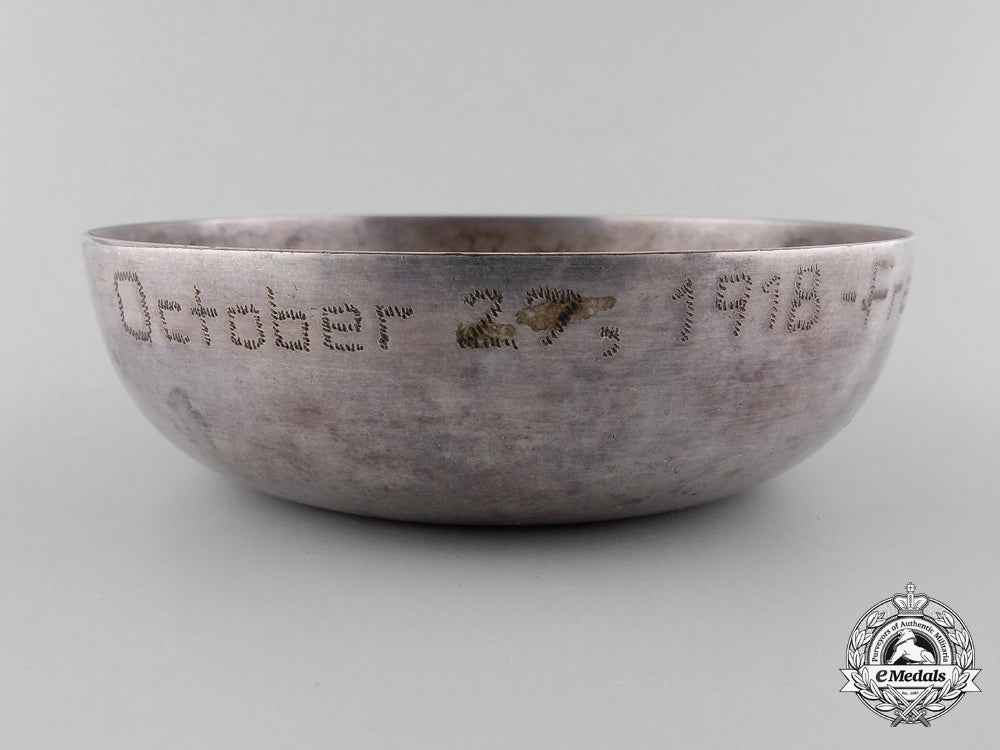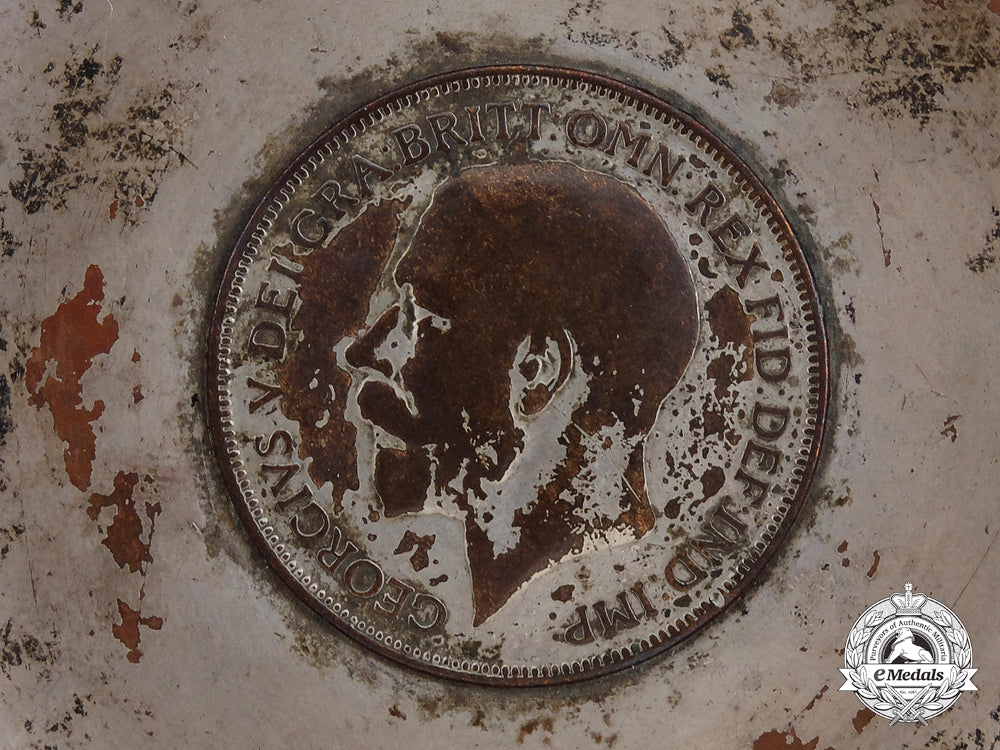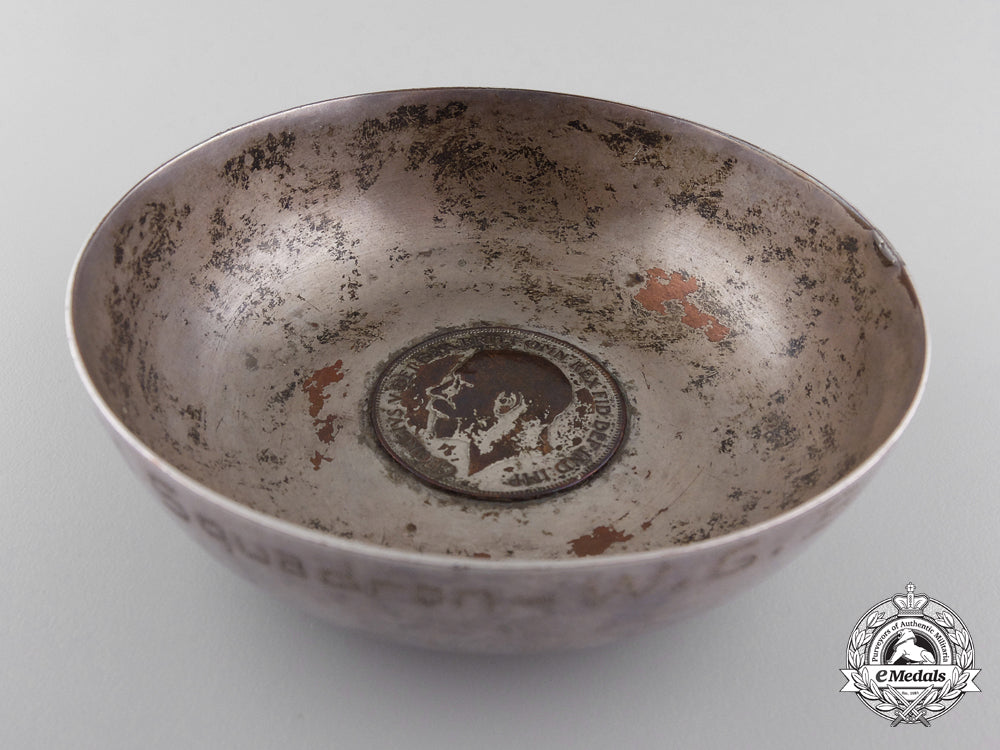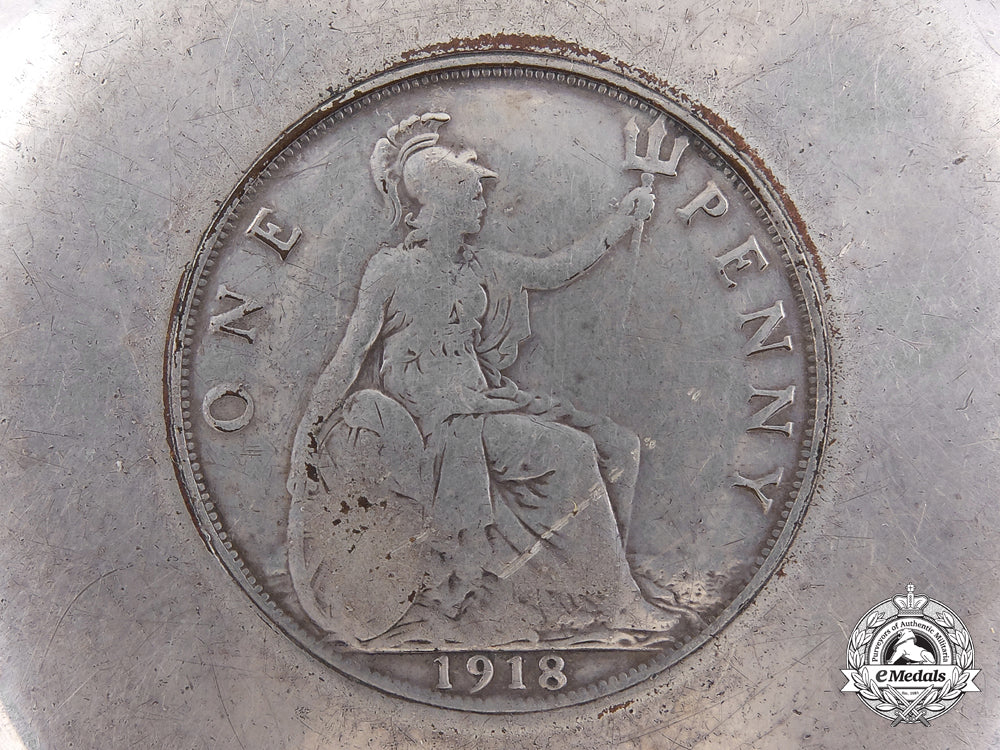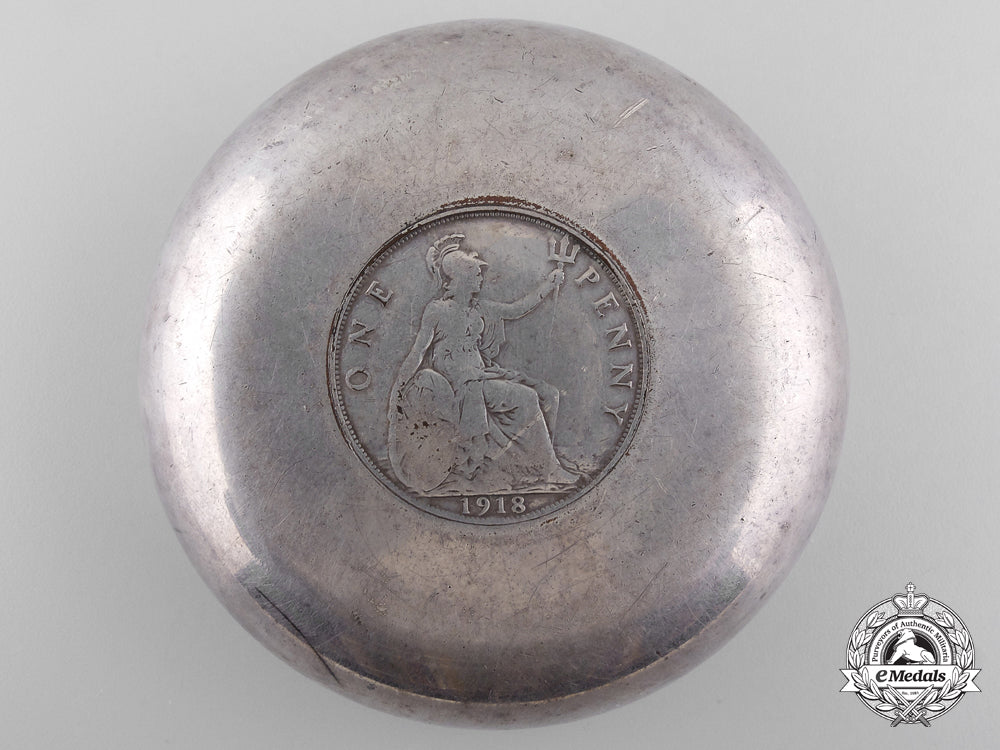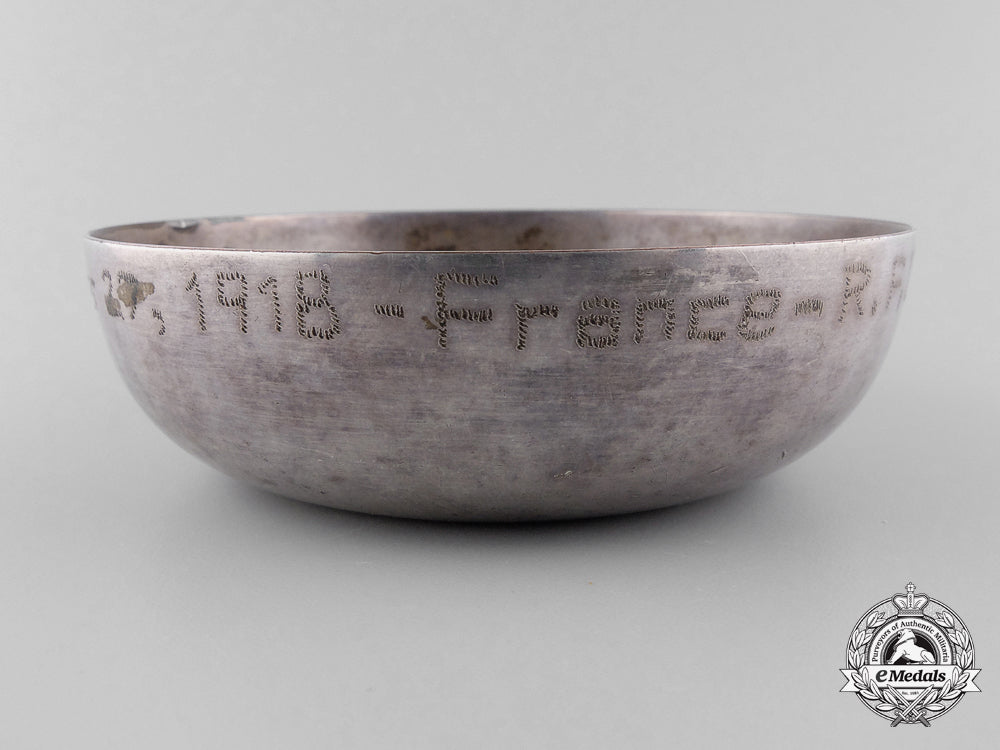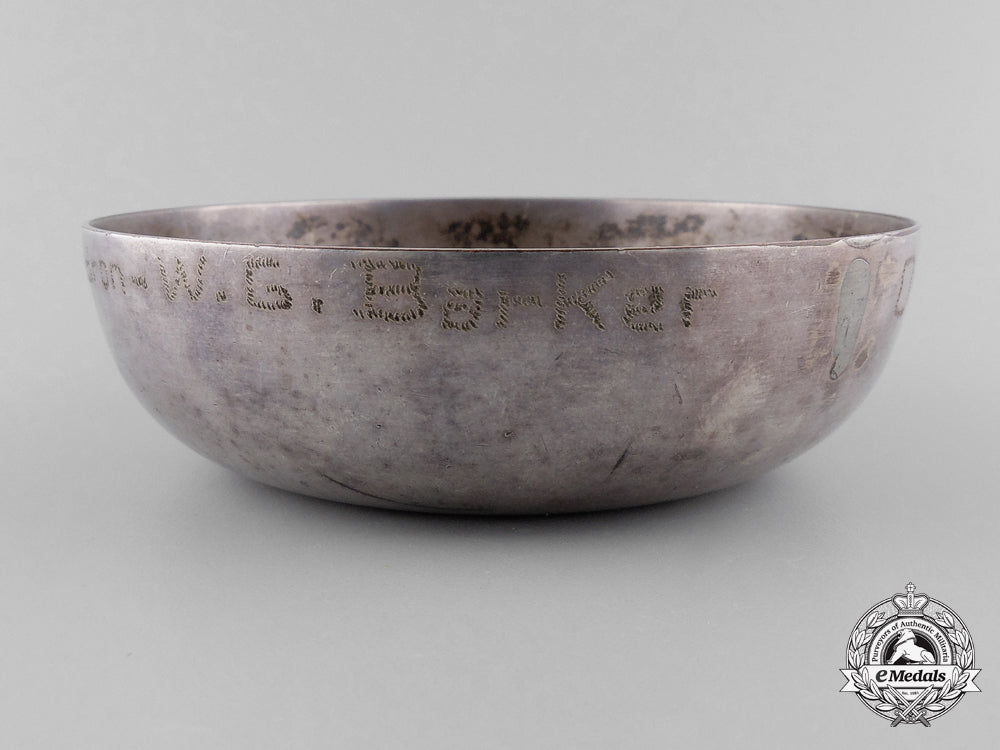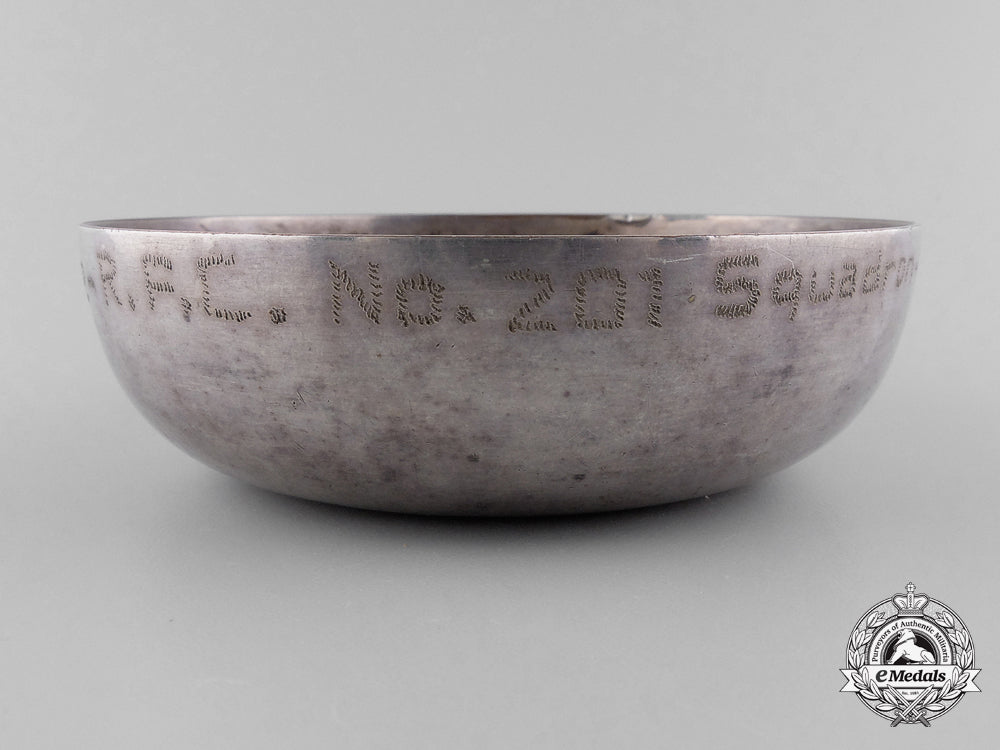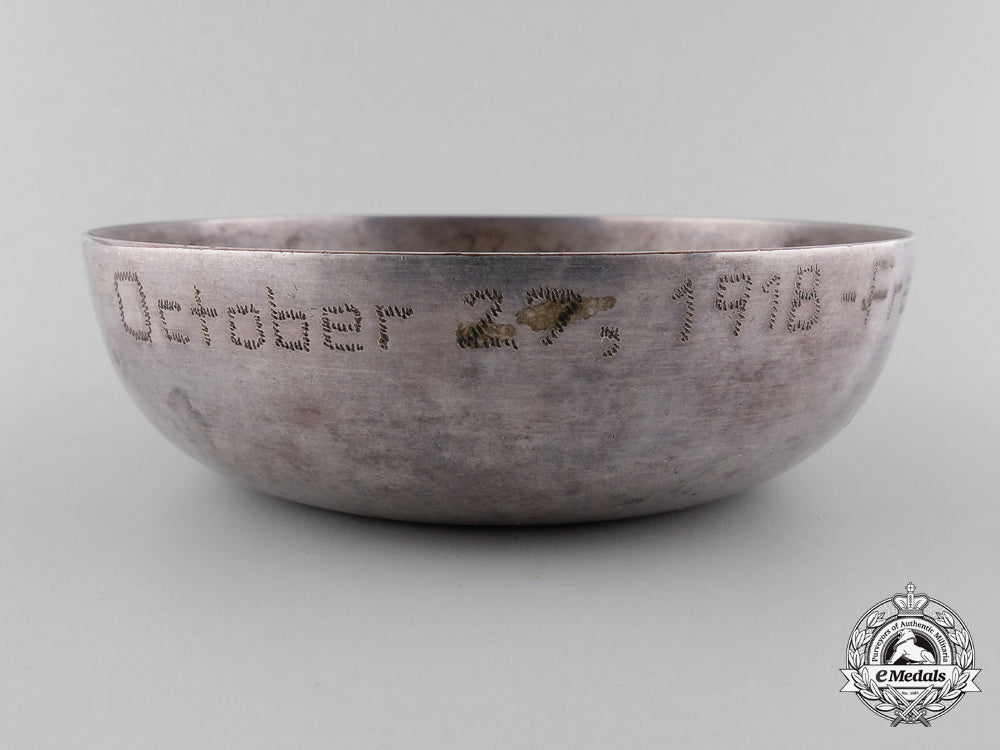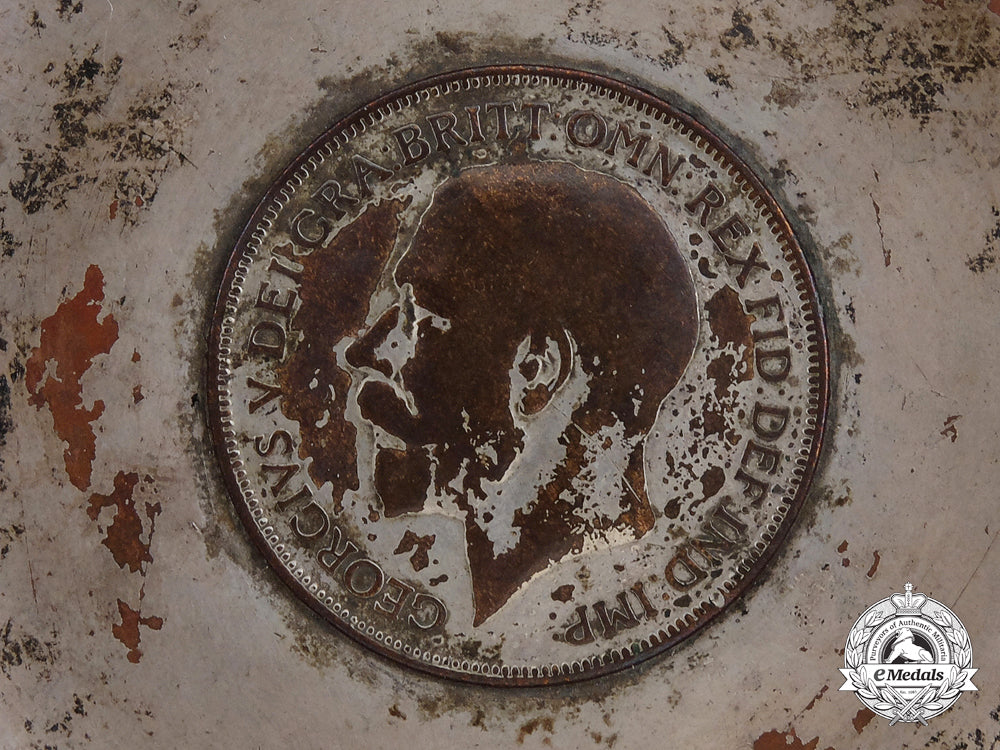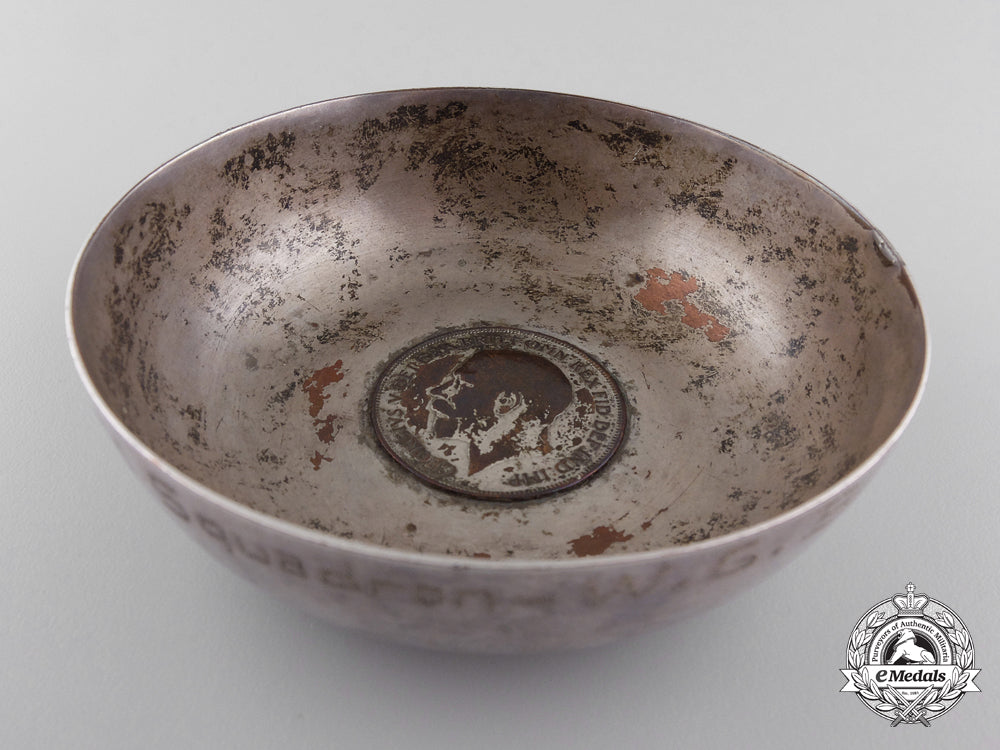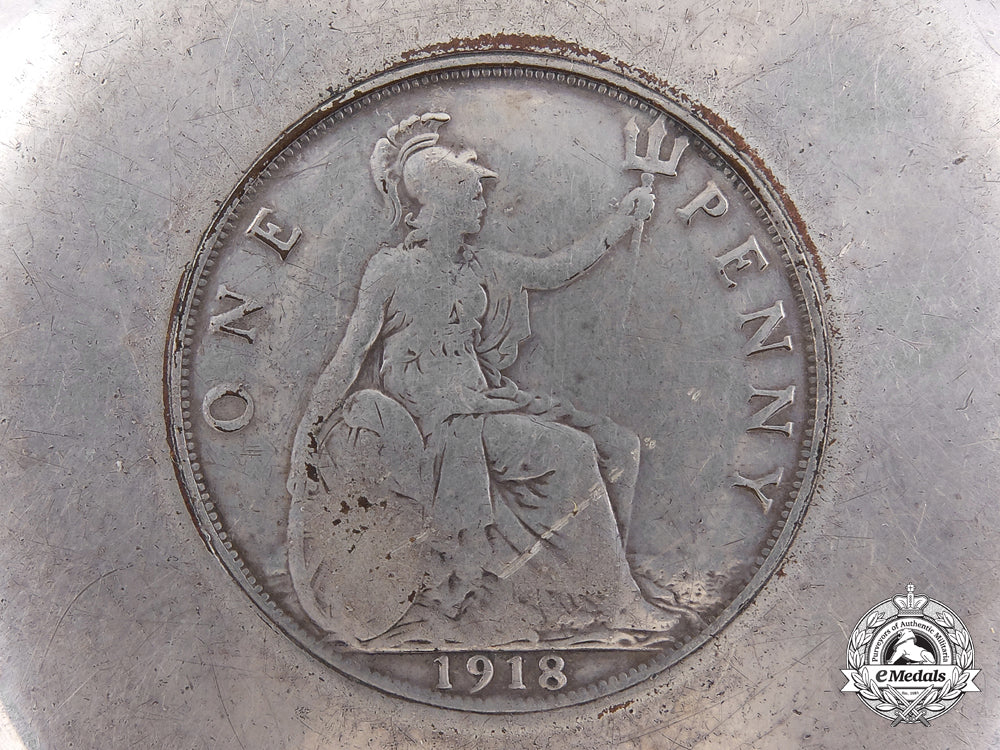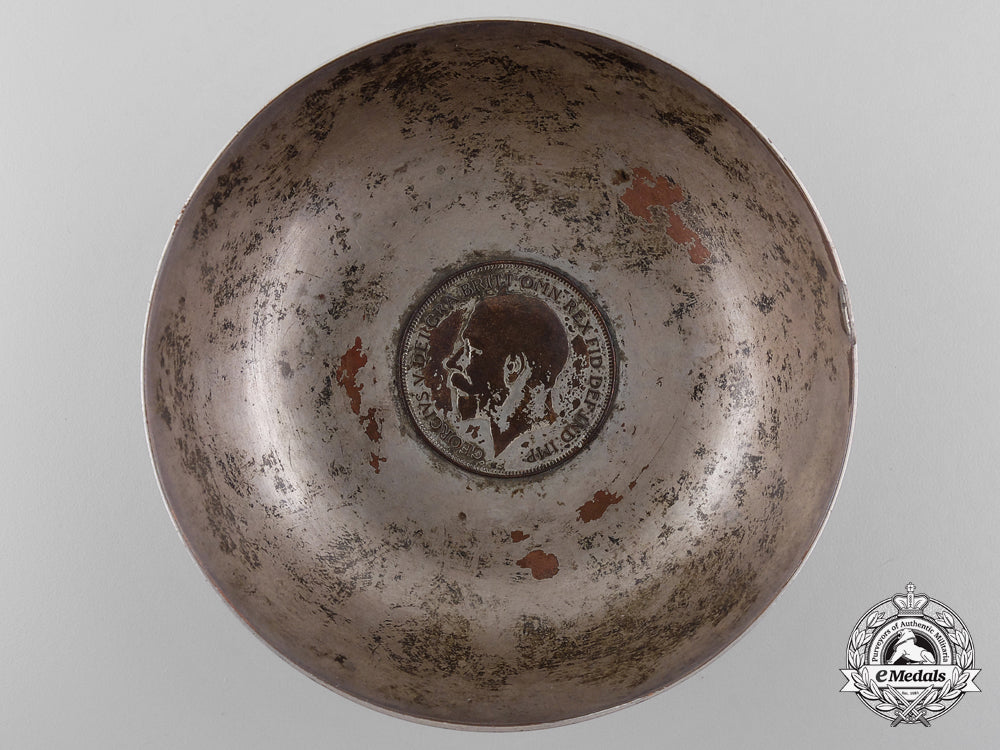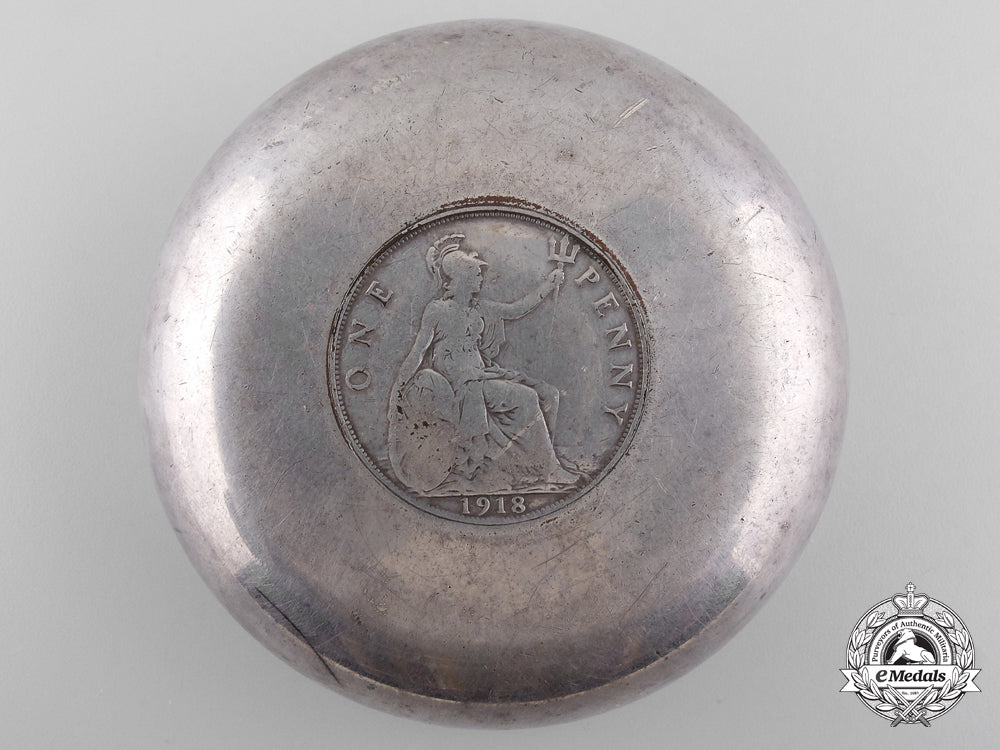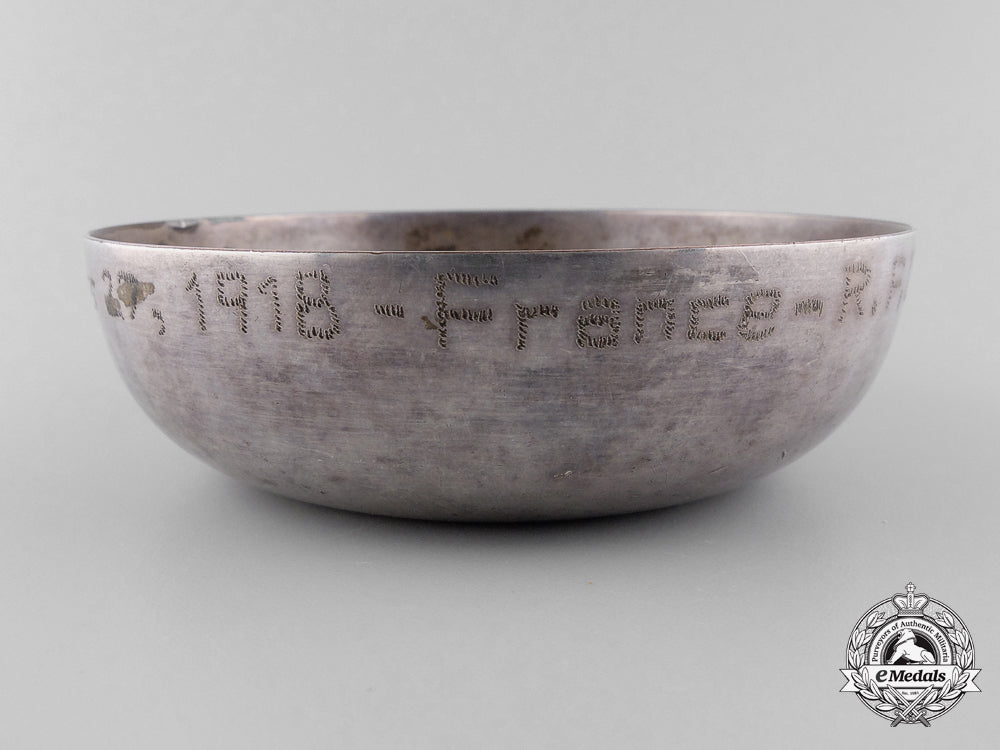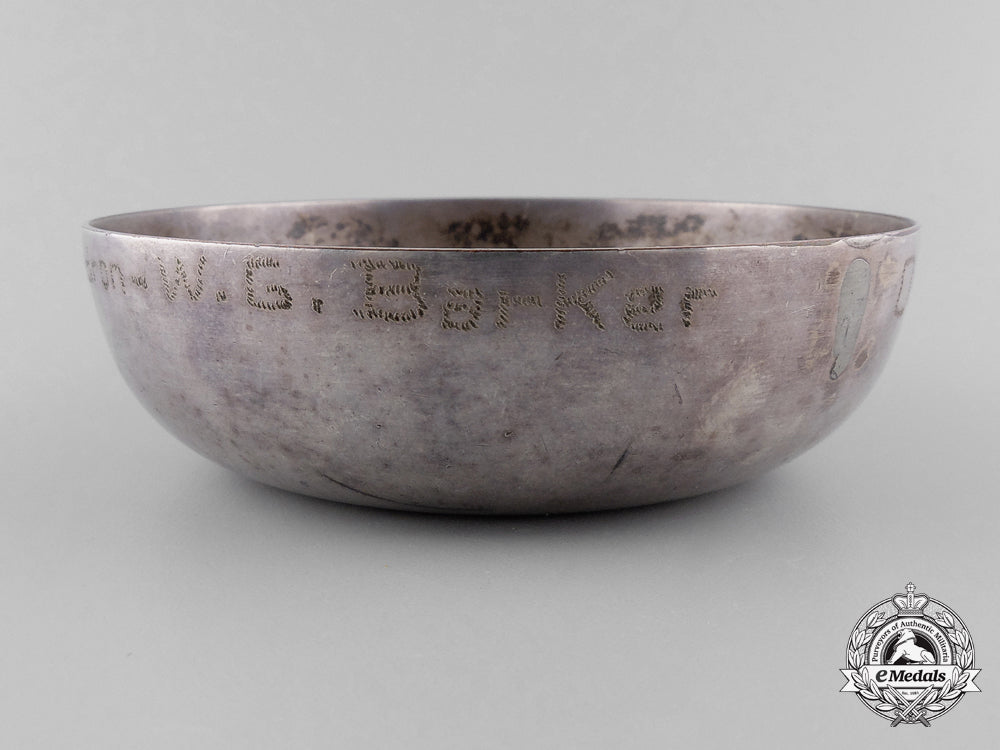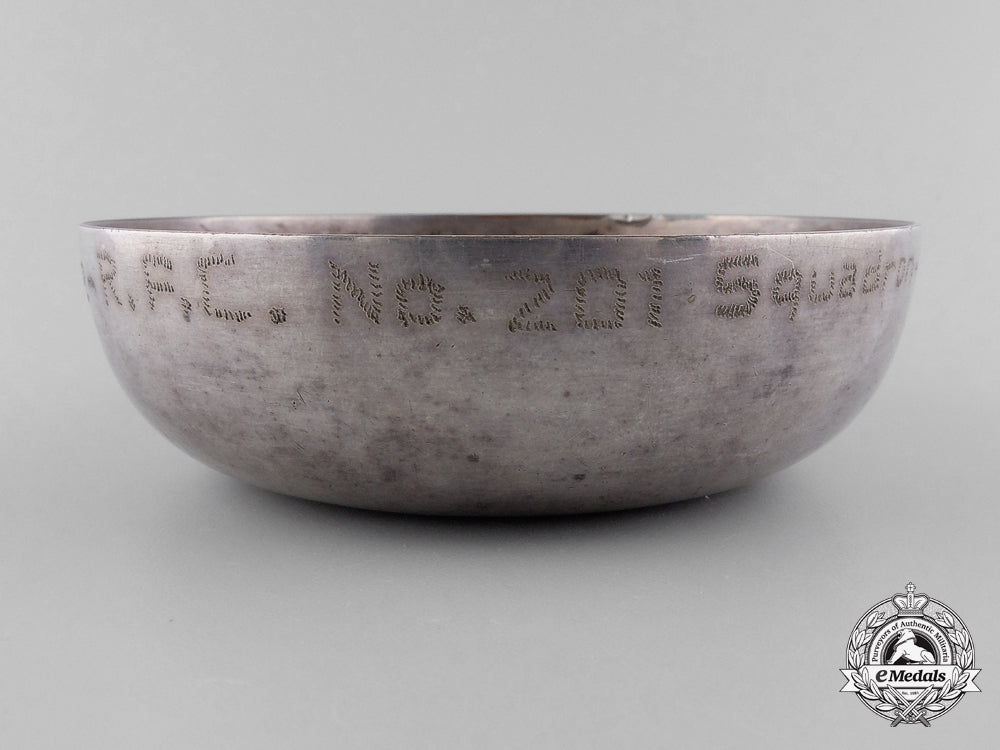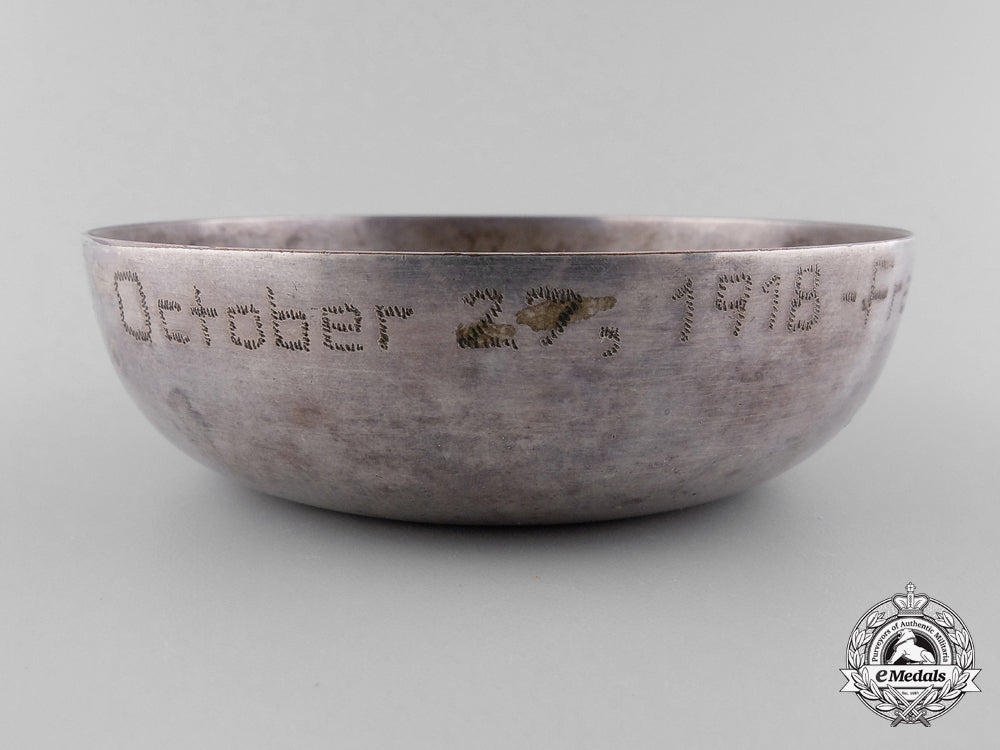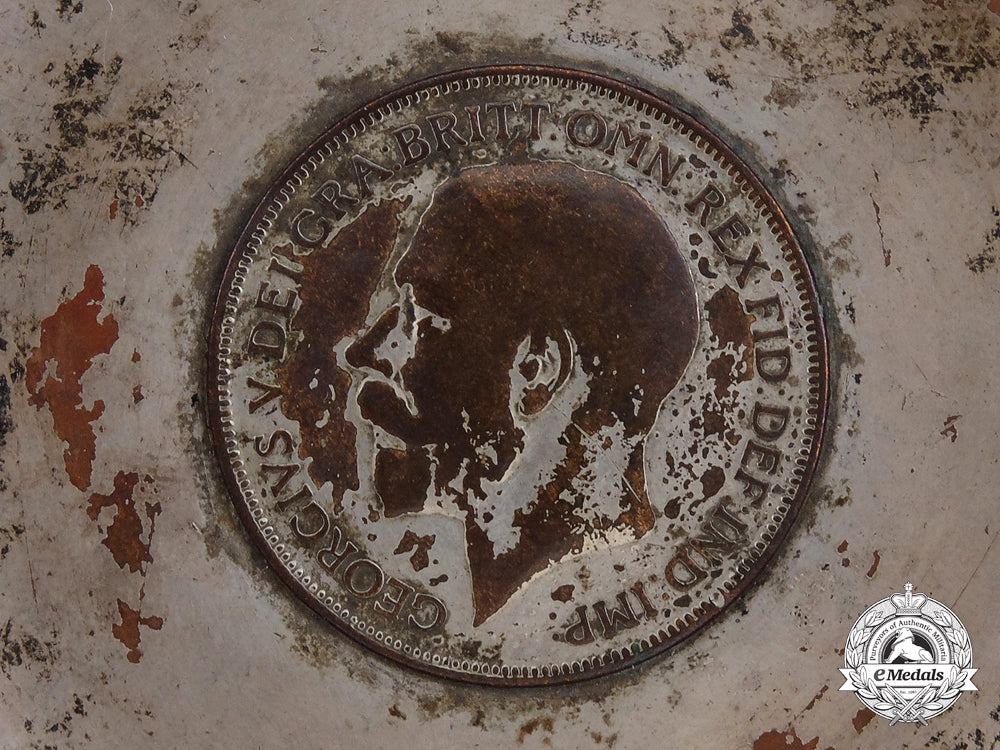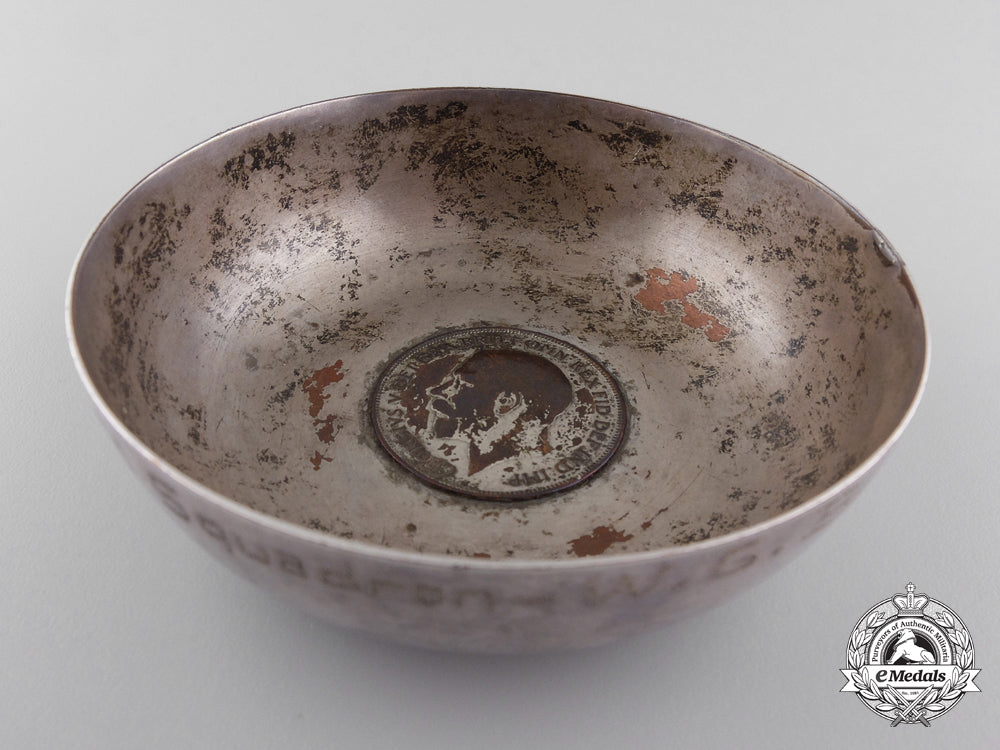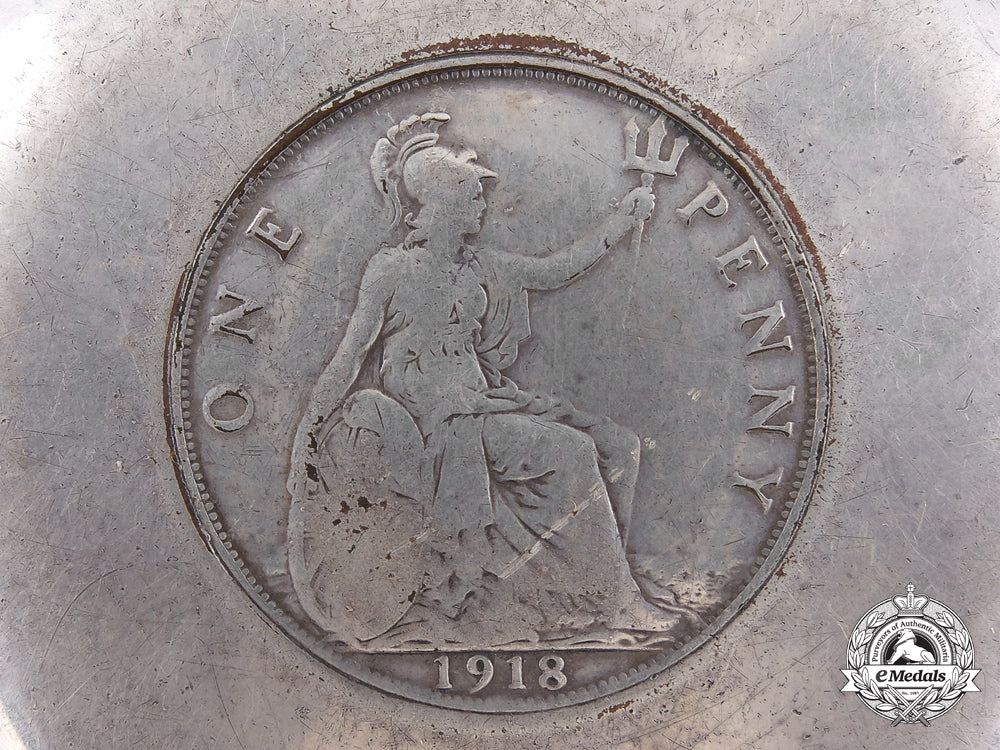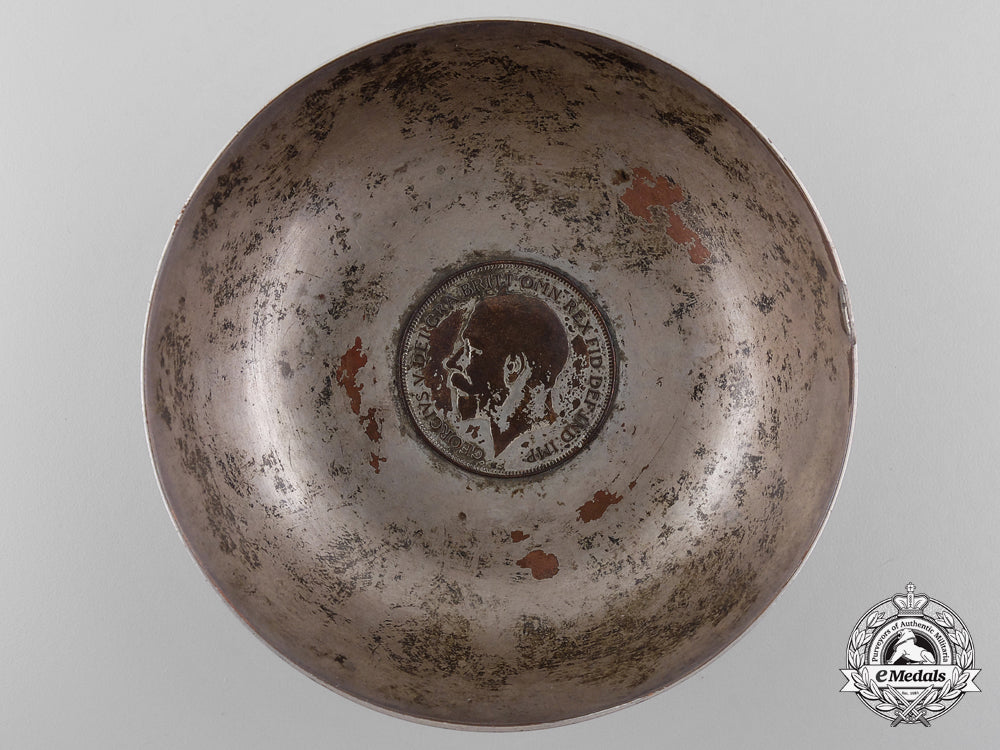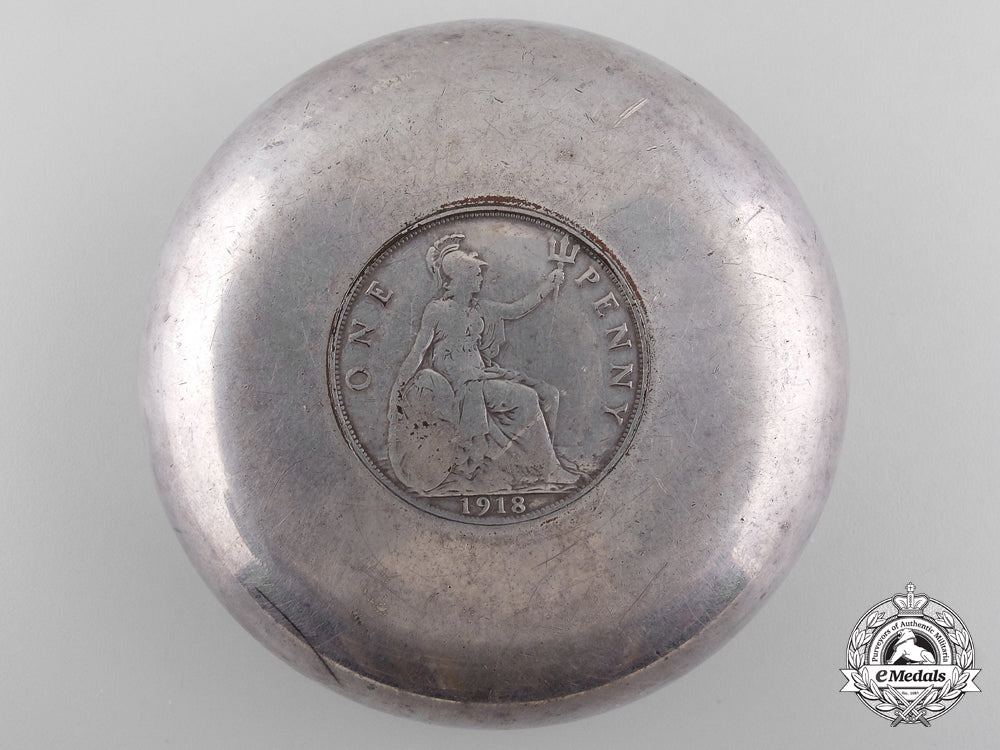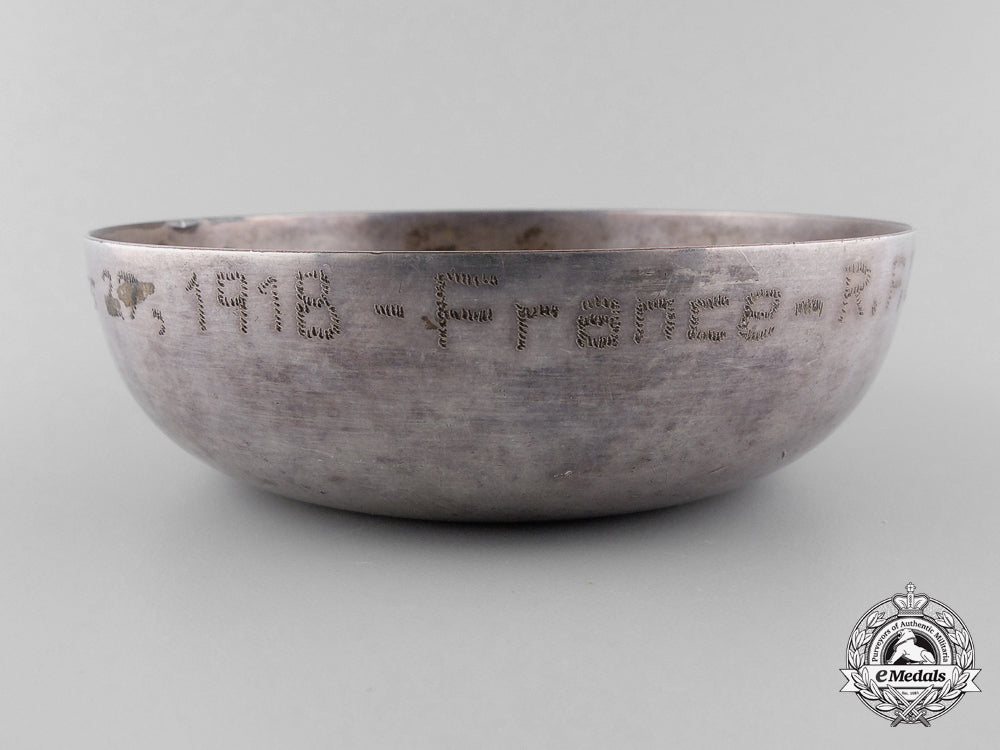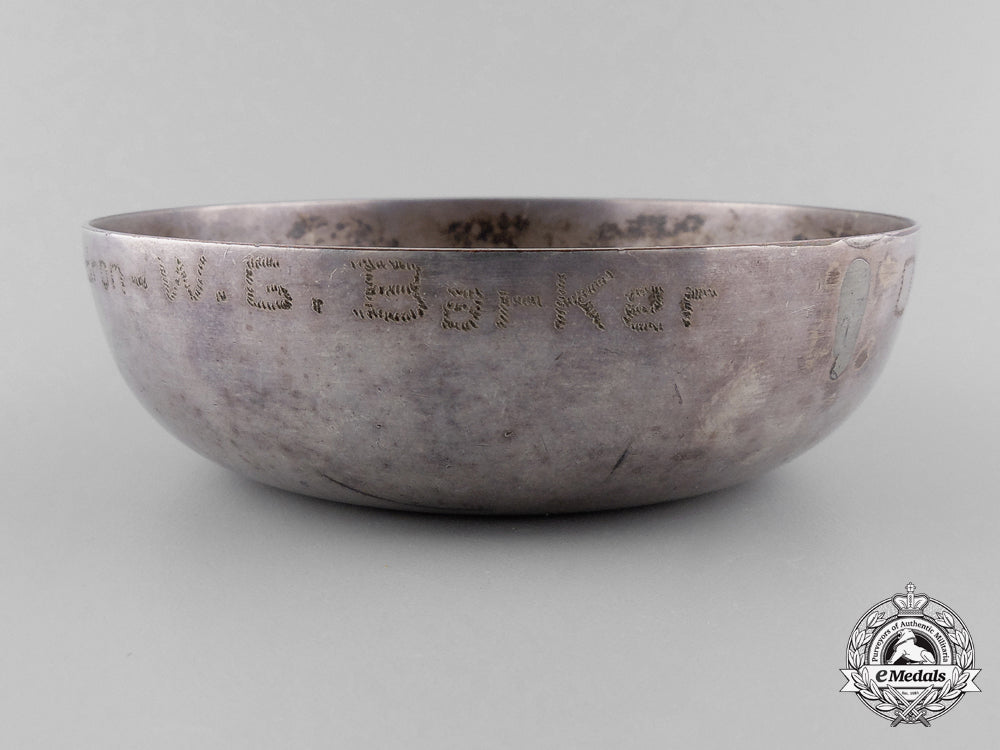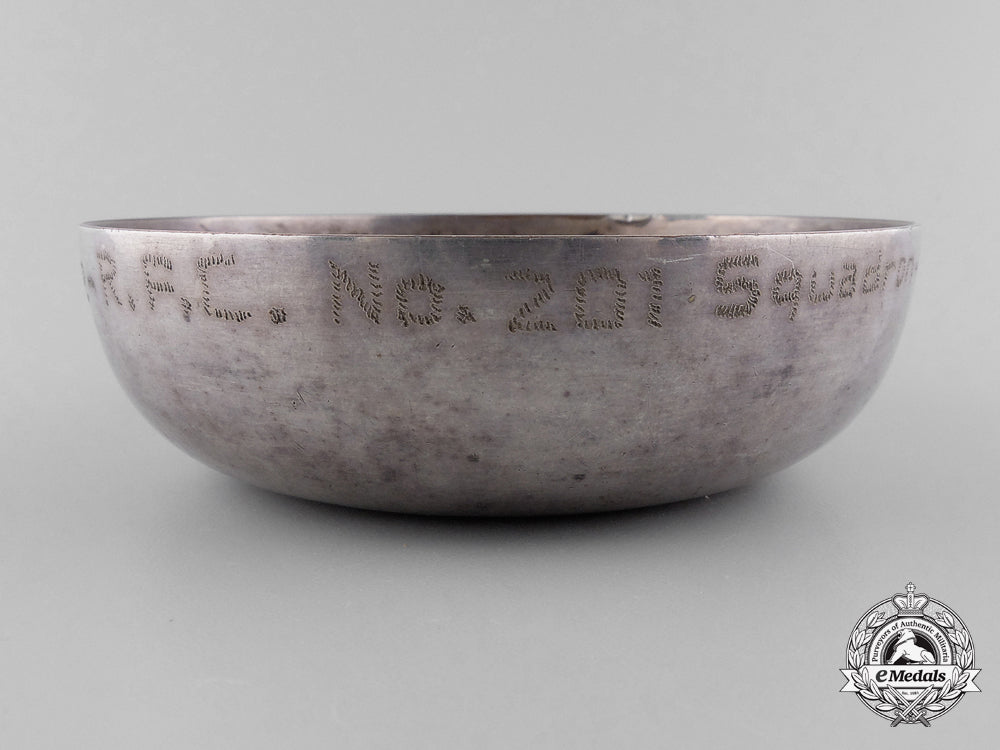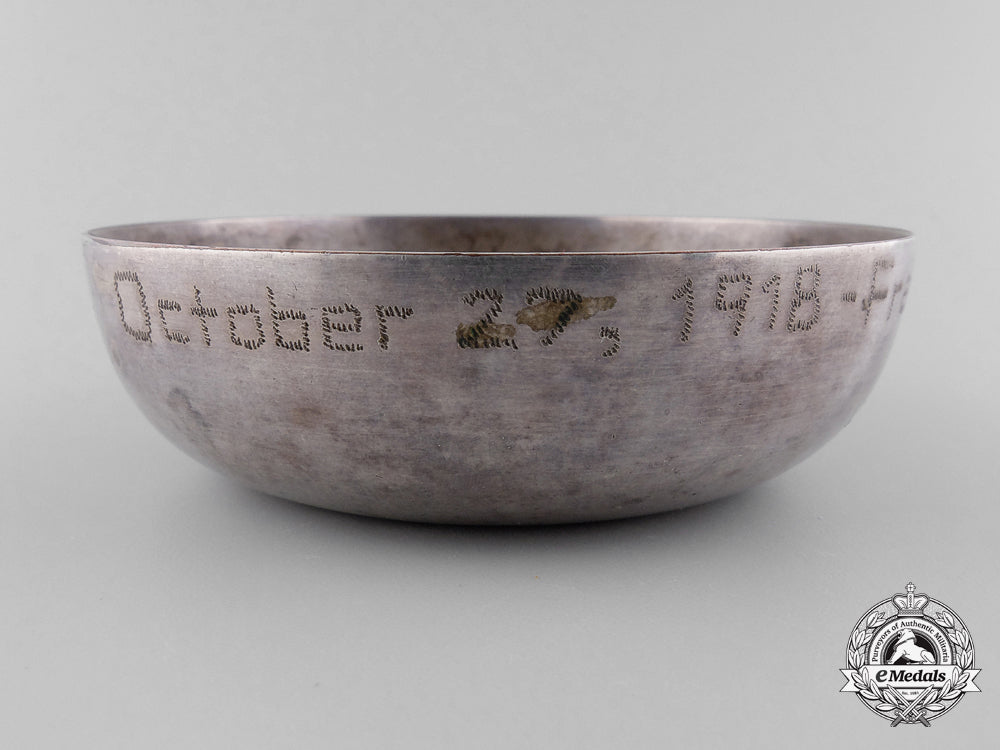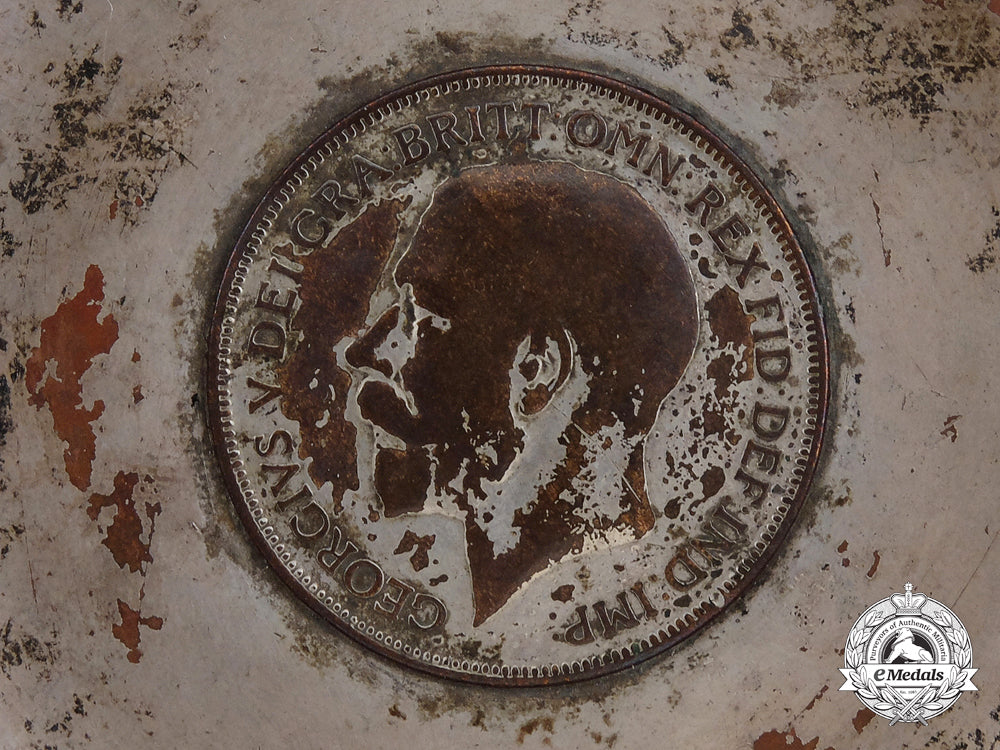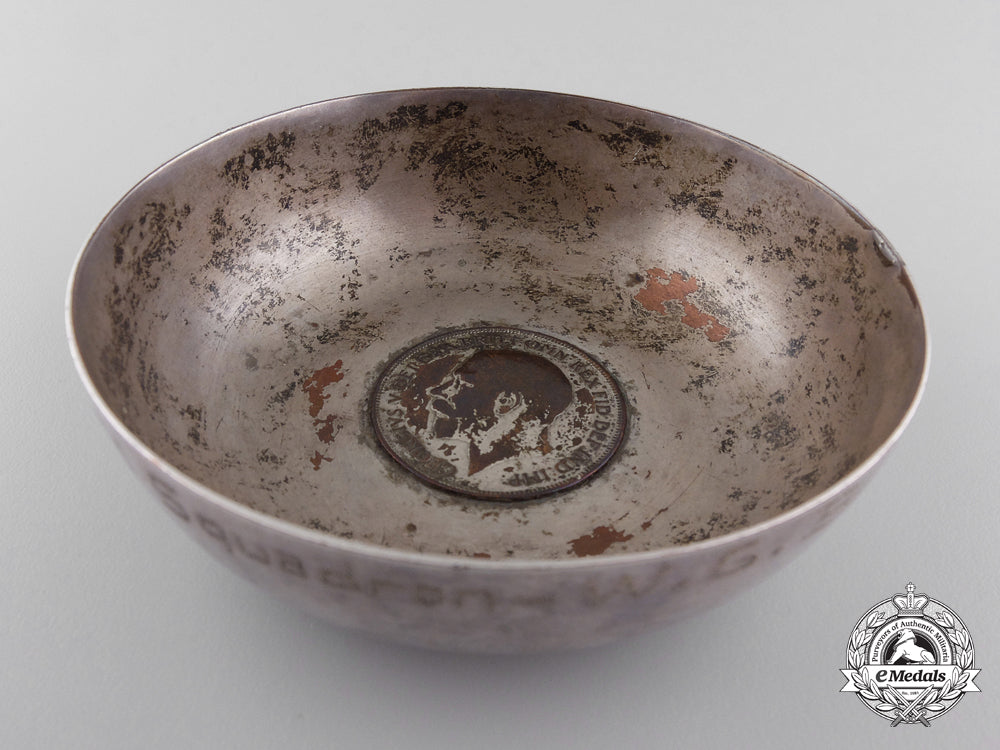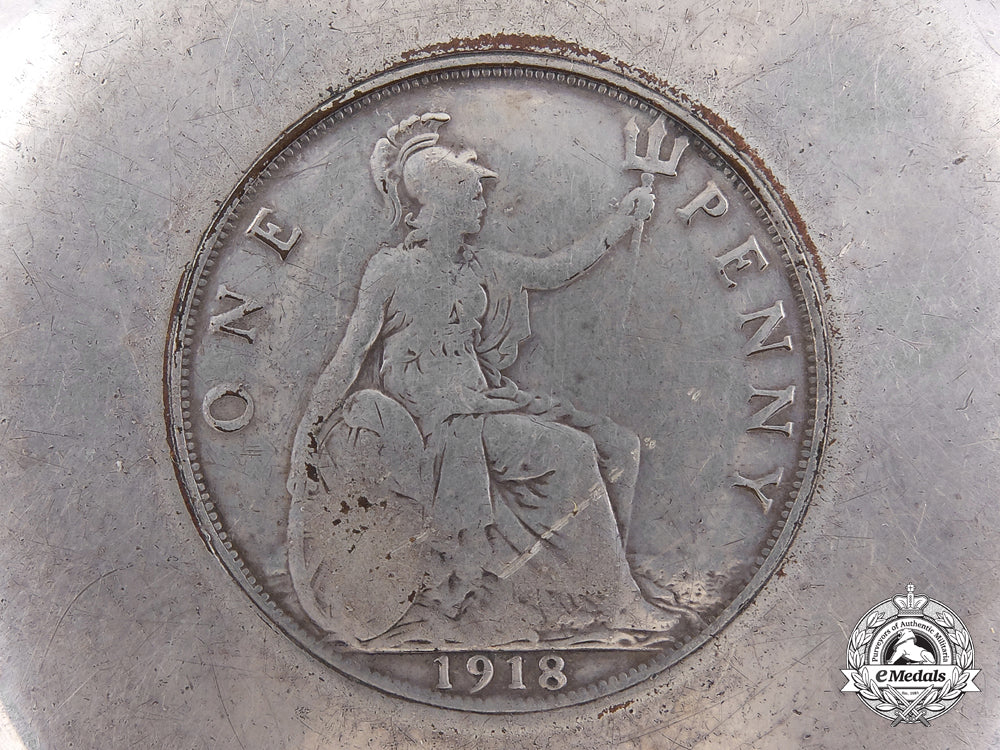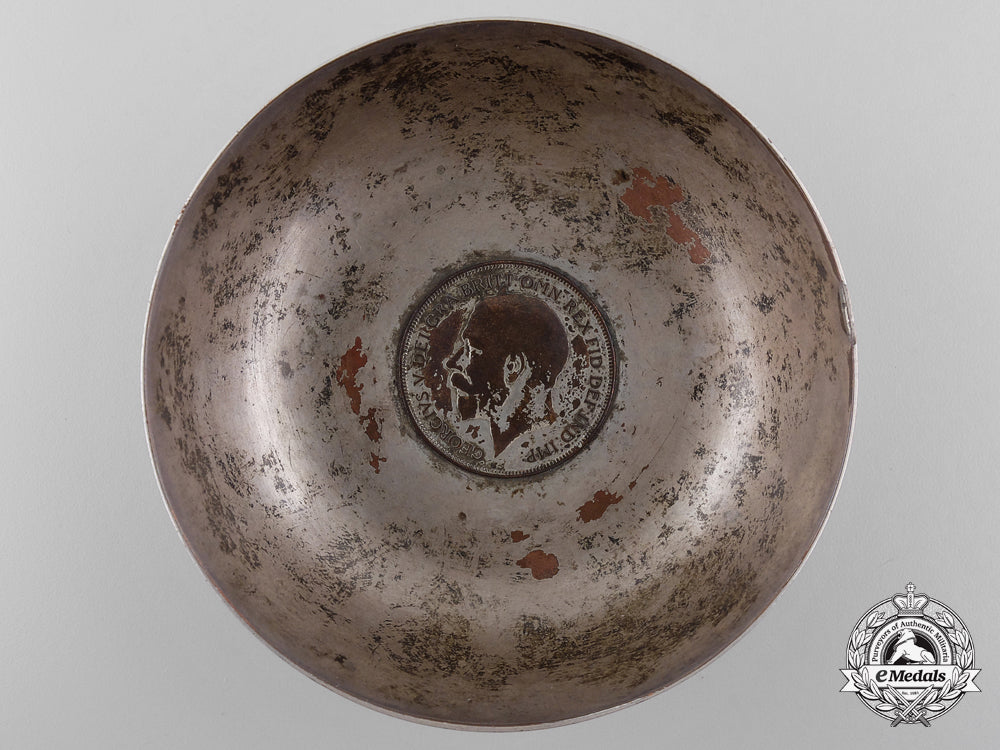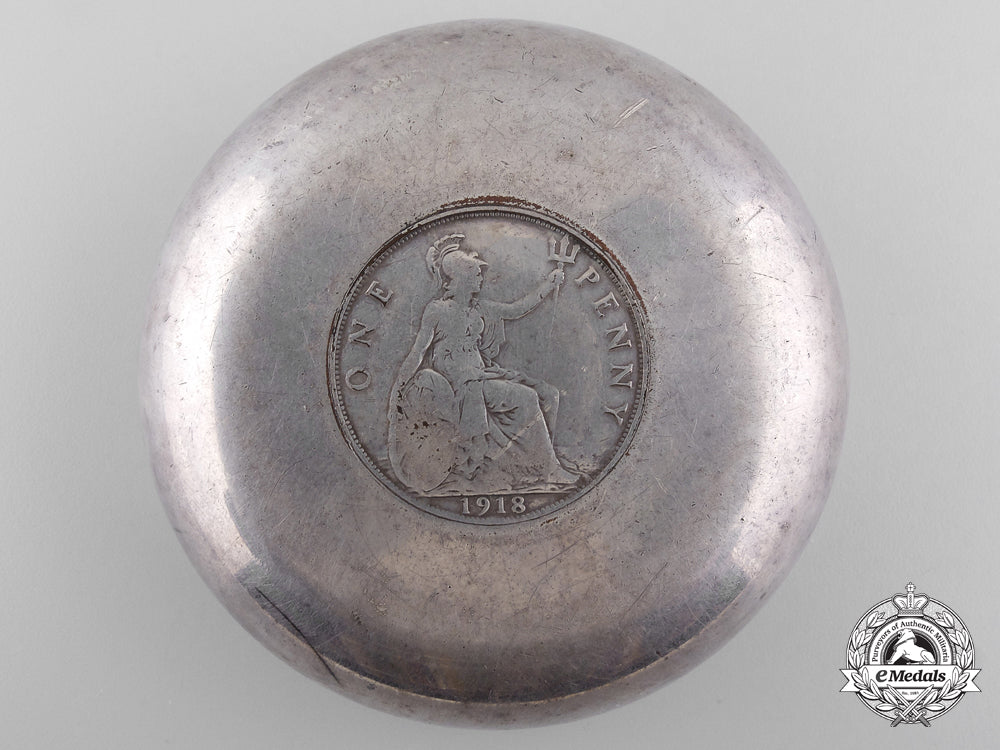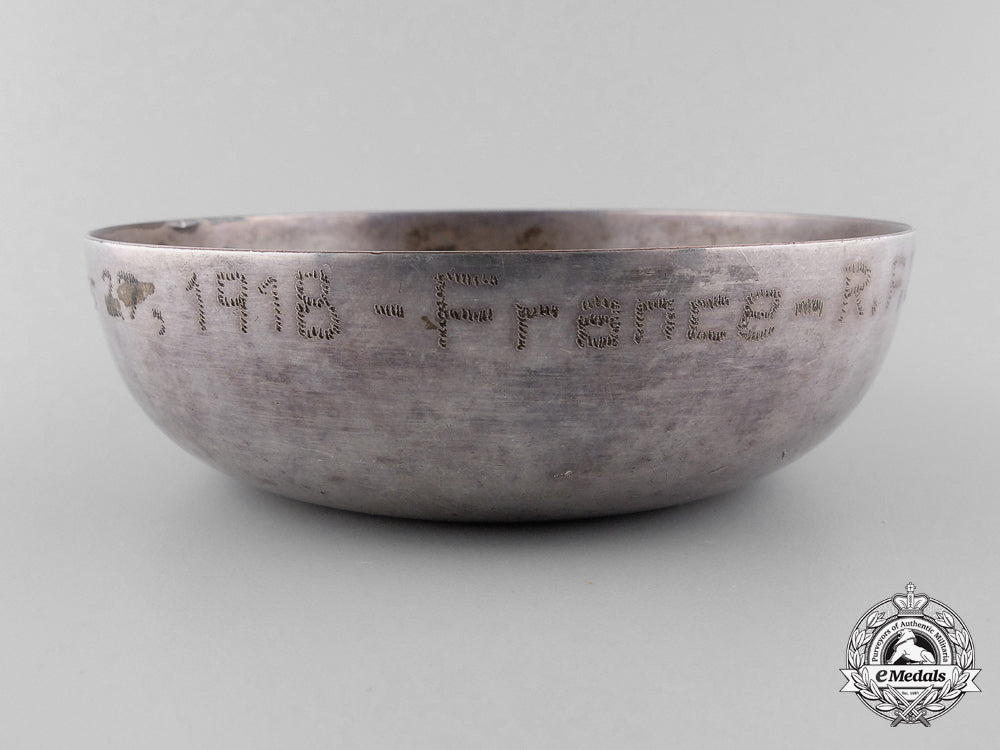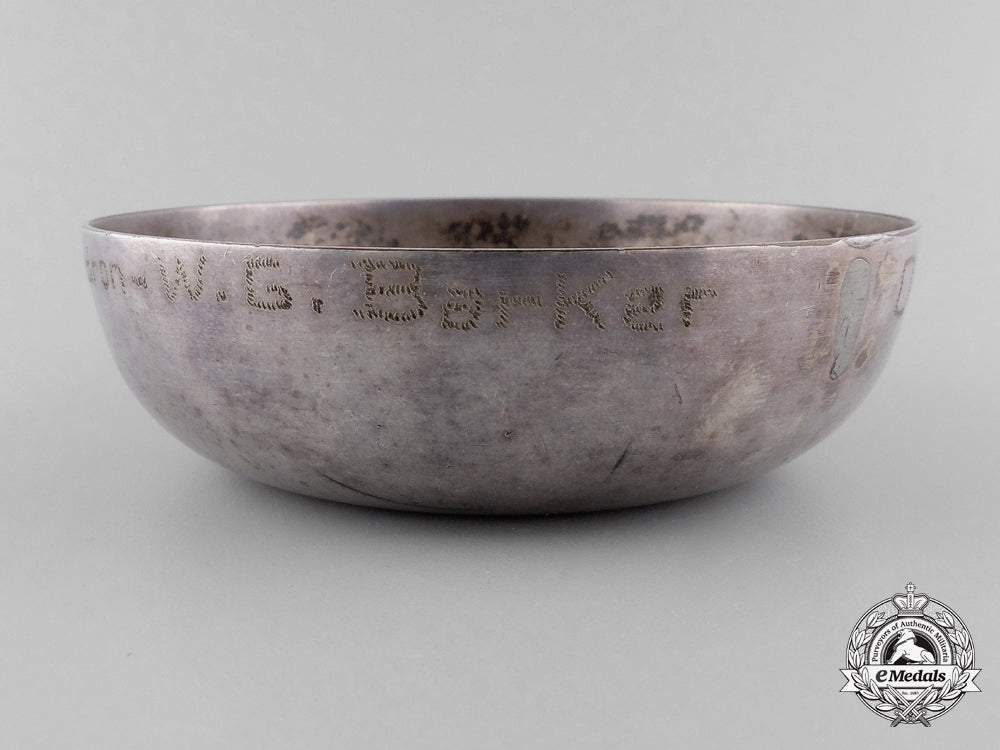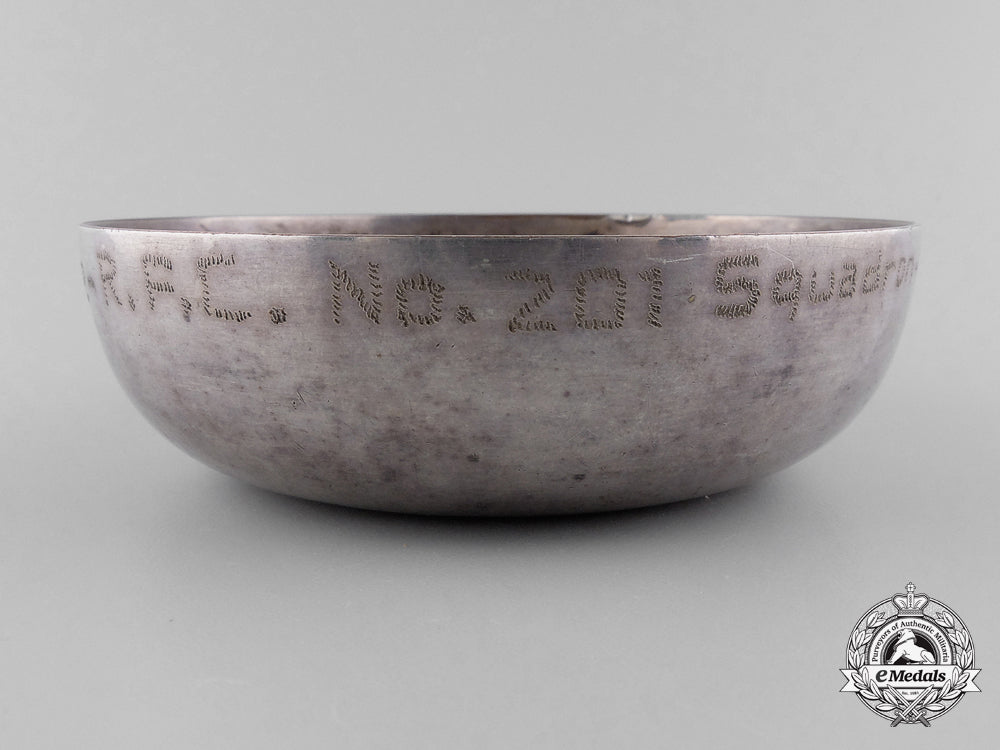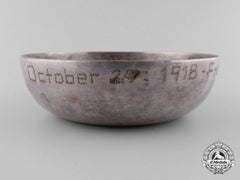Description
To the "the most decorated war hero in the history of Canada, the British Empire, and the Commonwealth of Nations": Silvered copper, with a silvered copper 1918 British One Penny coin embedded in the base, engraved "October 27, 1918 - France - R.F.C. No. 201 Squadron - W.G. Barker" below the rim on the exterior, 82.5 mm in diameter x 22.5 mm in height, contact marks and service wear, very fine. Accompanied by four Photographs of the Ashtray (black and white, gloss finish, 202 mm x 253 mm each), a Toronto Star Newspaper Article (dated Tuesday, September 20, 2011) and assorted research papers.
Footnote: William George "Billy" Barker VC, DSO & Bar, MC & Two Bars, was born on the family farm in Dauphin, Manitoba, on November 3, 1894. "Will" Barker grew up on the frontier of the Great Plains, riding horses, shooting, and working as a youngster on his father's farm and sawmill. He was an exceptional shot, using a lever-action Winchester that he had modified with his own peep sight. He was particularly adept at shooting on the move, even while on horseback. One biographer has suggested that he could have been a trick shooter in a circus. He was physically poised, emotionally intense, with wide-ranging interests, and had an innate flair for the dramatic act. He was a very good student in school, but had frequent absences due to farm and sawmill life. He was the hunter providing food for the workers in the sawmill while still a young teenager, and missed classes because of this obligation. Barker fell in love with aviation after watching pioneer aviators flying Curtiss and Wright Flyer aircraft at farm exhibitions between 1910 and 1914. He was a Boy Scout at Russell, Manitoba, and a member of the 32nd Light Horse, a Non-Permanent Active Militia unit based at Roblin, Manitoba. He was in Grade 11 at Dauphin Collegiate Institute in the fall of 1914, just before his enlistment. On December 23, 1914, soon after the outbreak of the First World War and the subsequent call to arms in the Dominion of Canada, Barker enlisted with the 1st Canadian Mounted Rifles, signing his Attestation Paper as a Trooper (106074) in Brandon, Manitoba, at the age of 20, naming his next-of-kin as his father, G.W.J. Barker of Dauphin, stating that he had served at Camp Sewell with the 32nd Light Horse, that he was not married and that his trade was that of Student at Collegiate. The regiment went to England in June 1915 and then to France on September 22nd of that year. Barker was a Colt machine gunner with the regiment's machine gun section until late February or early March 1916, and after eight months in the trenches, he was transferred as a probationary Observer to 9 Squadron of the Royal Flying Corps on April 2, 1916, flying in Royal Aircraft Factory B.E.2 aircraft. He was commissioned as a Second-Lieutenant in April and was given five days leave in London, to acquire an officer's uniform and equipment. On his return, he was assigned to 4 Squadron on April 7th and on July 18th was transferred to 15 Squadron, still flying in the B.E.2. On July 21st, Barker claimed a Roland scout 'driven down' with his observer's gun, and in August claimed a second Roland, this time in flames. He was Mentioned in Despatches around this time. He officially qualified as an Observer on August 27th and by September 15th, worked for the first time with Canadian troops, including his old regiment. On November 15th, Barker and his pilot, flying very low over the Ancre River, spotted a large concentration of German troops massing for a counter-attack on Beaumont Hamel. The crew sent an emergency Zone Call brought to bear all available artillery fire in the area onto the specified target. The force of some 4,000 German infantry was effectively broken up. He was awarded the Military Cross for this action in the concluding stages of the Battle of the Somme. The citation for Captain Barker's Military Cross appeared in the Second Supplement to the London Gazette 29898 of Tuesday, January 9, 1917, on Wednesday, January 10, 1917, page 455: "For conspicuous gallantry in action. He flew at a height of 500 feet over the enemy's lines, and brought back most valuable information. On another occasion, after driving off two hostile machines, he carried out an excellent photographic reconnaissance."
In January 1917, after spending Christmas on leave in London, he commenced pilot training at Netheravon, flying solo after fifty-five minutes of dual instruction. On February 24, 1917, he returned to serve a second tour on Corps Co-operation machines as a pilot, flying B.E.2s and R.E.8s with 15 Squadron. On March 25th, Barker claimed another scout 'driven down'. On April 25, 1917 during the Arras Offensive, Barker, flying an R.E.8 with observer Lt. Goodfellow, spotted over 1,000 German troops sheltering in support trenches. The duo directed artillery fire into the positions, thereby avoiding a counter-attack. He was awarded the 1st Bar to his Military Cross as a Captain, the citation appearing in the Second Supplement to the London Gazette 30188 of Tuesday, July 17, 1917, on Wednesday, July 18, 1917, page 7216: "For conspicuous gallantry and devotion to duty. He has done continuous good work in co-operation with the artillery, and has carried out successful reconnaissances under most difficult and dangerous conditions." He was later awarded a 2nd Bar to the Military Cross, the citation appearing in the Third Supplement to the London Gazette 30901 of Friday, September 13, 1918, on Monday, September 16, 1918, page 10877: "For conspicuous gallantry and devotion to duty. When leading patrols he on one occasion attacked eight hostile machines, himself shooting down two, and on another occasion seven, one of which he shot down. In two months he himself destroyed four enemy machines and drove down one and burned two balloons." He was graded as a Pilot in July 1917, then joined No. 47 Squadron on July 12th. Barker was wounded in the head by anti-aircraft fire on August 7, 1917, then briefly with No. 15 Squadron as on August 17th. After a short spell in the United Kingdom as an instructor, Barker's continual requests for front line service resulted in him being transferred to become a scout pilot, being offered a post with either 56 Squadron or 28 Squadron. He chose command of C Flight in the newly formed 28 Squadron, flying the Sopwith Camel that he preferred over the S.E.5s of 56 Squadron. Although Barker was reportedly not a highly skilled pilot, suffering several flying accidents during his career, he compensated for this deficiency with an aggressiveness in action and highly accurate marksmanship. The unit moved to France on October 8, 1917, with Barker downing an Albatros DV on his first patrol, though he did not claim it, as the patrol was unofficial. He claimed an Albatros of Jasta 2 (Lt. Lange, killed) on October 20th, and two more, of Jasta 18, on October 27th (Lt. Schober killed, Offstv. Klein, force landed). On November 7, 1917, 28 Squadron was transferred to Italy with Barker temporarily in command, and most of the unit, including aircraft, travelled by train to Milan. On November 29th, he downed an Austrian Albatros D.III flown by Lt. Haertl of Jasta 1 near Pieve di Soligo. A Jasta 39 pilot was shot down and killed and a balloon of BK 10 destroyed on December 3rd. One of his most successful, and also most controversial raids, fictionalized by Ernest Hemingway in the short story The Snows of Kilimanjaro, was on December 25, 1917. Catching the Germans off guard, he and Lt. Harold Hudson, his wingman, shot up the airfield of Fliegerabteilung (A) 204, setting fire to one hangar and damaging four German aircraft before dropping a placard wishing their opponents a "Happy Christmas." Lt. Lang of Jasta 1 was killed by Barker on January 1, 1918, and two balloons, two Albatros fighters (one flown by Feldwebel Karl Semmelrock of Flik 51J) and a pair of two-seaters fell to Barker during February. He later also claimed three more Albatros and an observation balloon. Temporary Captain Barker was awarded the Distinguished Service Order, his citation appearing in the Third Supplement to the London Gazette 30530 of Friday, February 15, 1918, on Monday, February 18, 1918, page 2156: "For conspicuous gallantry and devotion to duty. When on scouting and patrol work he has on five different occasions brought down and destroyed five enemy aeroplanes and two balloons, though on two of these occasions he was attacked by superior numbers. On each occasion the hostile machines were observed to crash to earth, the wreckage bursting into flames. His splendid example of fearlessness and magnificent leadership have been of inestimable value to his squadron." As a Captain (Temporary Major), he was awarded the Bar to the Distinguished Service Order, his citation appearing in the Second Supplement to the London Gazette 30989 of Friday, November 1, 1918, on Saturday, November 2, 1918, page 12959: "A highly distinguished patrol leader whose courage, resource and determination has set a fine example to those around him. Up to the 20th July, 1918, he had destroyed thirty-three enemy aircraft - twenty-one of these since the date of the last award (second Bar to the Military Cross) was conferred on him. Major Barker has frequently led the formation against greatly superior numbers of the enemy with conspicuous success." Owing to his tendency to ignore orders by flying many unofficial patrols, Barker was passed over when the post of Commanding Officer of 28 Squadron became vacant. Dissatisfied, he applied for a posting and joined 66 Squadron on April 10, 1918, where he claimed a further 16 kills by mid-July. On April 17th, he shot down Oblt. Gassner-Norden of Flik 41J, flying an Albatros D.III (Oef), over Vittorio. He then became Squadron Commander of 139 Squadron on July 14, 1918, flying the Bristol Fighter. Barker however took his Sopwith Camel with him and continued to fly fighter operations. He carried out an unusual sortie on the night of August 9th, when he flew a Savoia-Pomilio SP.4 bomber to land a spy behind enemy lines. By this time, Barker's personal Sopwith Camel (serial no. B6313) had become the most successful fighter aircraft in the history of the RAF, having used it to shoot down 46 aircraft and balloons from September 1917 to September 1918, for a total of 404 operational flying hours. It was dismantled in October 1918, Barker keeping the clock as a memento, although he was asked to return it the following day. During this time Barker trialed a series of modifications to B6313, in order to improve its combat performance. The Clerget rotary engine's cooling efficiency was poorer in the hotter Italian climate, so several supplementary cooling slots were cut into the cowling. The poor upward visibility of the Camel resulted in Barker cutting away progressively larger portions of the centre-section fabric. He also had a rifle-type, notch and bead gun-sight arrangement replace the standard gun sight fitting. Having flown more than 900 combat hours in two and one half years, Barker was transferred back to the United Kingdom on September 30, 1918, to command the fighter training school at Hounslow Heath Aerodrome. Barkerended his Italian service with some 33 airplanes claimed destroyed and nine observation balloons downed individually or with other pilots. At Royal Air Force Headquarters in London, he persuaded his superiors he needed to get up to date on the latest combat techniques in France and he was granted a ten-day roving commission in France, wherein he selected the Sopwith Snipe as his personal machine and attached himself to No. 201 Squadron RAF on October 17, 1918, whose Squadron commander, Major Cyril Leman, was a friend from his days as a Corps Co-operation airman. He was awarded the Victoria Cross for his actions on day ten, Sunday, October 27, 1918. While returning his Snipe to an aircraft depot, he crossed enemy lines at 21,000 feet above the Forêt de Mormal. He attacked an enemy Rumpler two-seater which broke up, its crew escaping by parachute (the aircraft was of FAA 227, Observer Lt. Oskar Wattenburg killed). By his own admission, he was careless and was bounced by a formation of Fokker D.VIIs of Jagdgruppe 12, consisting of Jasta 24 and Jasta 44. In a descending battle against 15 or more enemy machines, Barker was wounded three times in the legs, then his left elbow was blown away, yet he managed to control his Snipe and shoot down or drive down three more enemy aircraft (two German pilot casualties were Lt. Hinky of Jasta 44, wounded; and Vfw. Alfons Schymik of Jasta 24, killed). The dogfight took place immediately above the lines of the Canadian Corps. Severely wounded and bleeding profusely, Barker force landed inside Allied lines, his life being saved by the men of an RAF Kite Balloon Section who transported him to a field dressing station (The fuselage of his Snipe aircraft was recovered from the battlefield and is preserved at the Canadian War Museum, Ottawa, Ontario). Acting Major Barkerwas awarded the Victoria Cross, his citation appearing in the Second Supplement to the London Gazette 31042 of Friday, November 29, 1918, on Saturday, November 30, 1918, page 14203: "On the morning of the October 27, 1918, this officer observed an enemy two-seater over the Foret de Mormal. He attacked this machine and after a short burst it broke up in the air. At the same time a Fokker biplane attacked him, and he was wounded in the right thigh, but managed, despite this, to shoot down the enemy aeroplane in flames. He then found himself in the middle of a large formation of Fokkers who attacked him from all directions, and was again severely wounded in the left thigh, but succeeded in driving down two of the enemy in a spin. He lost consciousness after that, and his machine fell out of control. On recovery, he found himself being again attacked heavily by a large formation, and singling out one machine he deliberately charged and drove it down in flames. During this fight his left elbow was shattered and he again fainted, and on regaining consciousness he found himself still being attacked, but notwithstanding that he was now severely wounded in both legs and his left arm shattered, he dived on the nearest machine and shot it down in flames. Being greatly exhausted, he dived out of the fight to regain our lines, but was met by another formation, which attacked and endeavored to cut him off, but after a hard fight he succeeded in breaking up this formation and reached our lines, where he crashed on landing. This combat, in which Major Barker destroyed four enemy machines (three of them in flames), brought his total successes to fifty enemy machines destroyed, and is a notable example of the exceptional bravery and disregard of danger which this very gallant officer has always displayed throughout his distinguished career." At a hospital in Rouen, France, Barker clung to life until mid-January 1919, and then was transported back to England. He was not fit enough to walk the necessary few paces for the Victoria Cross investiture at Buckingham Palace until March 1, 1919. Barker is officially credited with one captured, two (and seven shared) balloons destroyed, 33 (and two shared) aircraft destroyed, and five aircraft "out of control", the highest "destroyed" ratio for any RAF, RFC or RNAS pilot during the conflict. The Overseas Military Forces of Canada recognized Barker as "holding the record for fighting decorations" awarded in the First World War. In addition he was Mentioned in Despatches and 'A' Listed three times; as a Captain, he was awarded the French Croix de Guerre as mentioned in the Second Supplement to the London Gazette 30913 of Friday, September 20, 1918, on Saturday September 21, 1918, page 11259; and as a Temporary Captain, he was awarded the Italian Silver Medal for Military Valour by the King of Italy, for Distinguished Services rendered in the course of the campaign, as mentioned in the Third Supplement to the London Gazette 30895 of Tuesday, September 10, 1918, on Thursday, September 12, 1918, page 10742 and in Flight Magazine on September 26, 1918. Barker returned to Canada in May 1919 as the most decorated Canadian of the war, with the Victoria Cross, the Distinguished Service Order and Bar, the Military Cross and two Bars, the Italian Silver Medal for Military Valour, and the French Croix de Guerre, as well as Mentioned in Despatches and 'A' Listed three times. The Canadian Daily Record, a publication of the Overseas Military Forces of Canada, wrote in December 1918 that William Barker of Dauphin, Manitoba was the Canadian holding the record for "most fighting decorations" in the war. No other Canadian soldier, sailor or airman has surpassed this record, and the Canadian War Museum exhibit, located in Ottawa, Ontario, states: "Lieutenant Colonel William G. Barker, one of the legendary aces of the war, remains the most decorated Canadian in military service." Air Marshal William Avery "Billy" Bishop, VC, CB, DSO & Bar, MC, DFC, ED, LL.D. described Barker as "The Deadliest Air Fighter that Ever Lived". A plaque on his tomb in the mausoleum of Toronto's Mount Pleasant Cemetery, officially unveiled on September 22, 2011, describes him as "The most decorated war hero in the history of Canada, the British Empire, and the Commonwealth of Nations." Barker formed a business partnership, Bishop-Barker Aeroplanes Limited, with fellow Victoria Cross recipient and Canadian ace Billy Bishop which lasted for about three years. In 1922, he rejoined the fledgling Canadian Air Force in the rank of Wing Commander, serving as the Station Commander of Camp Borden from 1922 to 1924. Barker was appointed acting director of the Royal Canadian Air Force in early 1924 and he graduated from Royal Air Force Staff College, Andover, in 1926. While waiting to start RAF Staff College Course No. 4, Barker spent two weeks in Iraq with the RAF to learn more about the uses of air power. He formally reported on his findings to the Minister of National Defence, and informally to Brigadier General Billy Mitchell, of the United States Air Service. One of his achievements in the RCAF was the introduction of parachutes. After leaving the RCAF, he became the first president of the Toronto Maple Leafs hockey club, and was involved in tobacco growing farms in southwestern Ontario. Barker continued to suffer from the physical effects of his 1918 gunshot wounds, his legs were permanently damaged and he suffered severely limited movement in his left arm. He also struggled with alcoholism in the last few years of his life. He died on March 12, 1930, when he lost control of his Fairchild KR-21 biplane trainer during a demonstration flight for the RCAF, at Air Station Rockcliffe, near Ottawa, Ontario. Barker, aged 35, was at the time the President and General Manager of Fairchild Aircraft in Montreal. His funeral, the largest national state event in Toronto's history, was attended by an honour guard of 2,000 soldiers. The cortege stretched for more than a mile and a half, and included the Chief of the General Staff and his senior officers, the Lieutenant Governor of Ontario, the Mayor of Toronto, three federal government cabinet ministers, and six other Victoria Cross recipients. An honour guard was also provided by the United States Army. Some 50,000 spectators lined the streets of Toronto en route to Mount Pleasant Cemetery, where Barker was interred in his wife's family crypt in the Mausoleum. In his hometown, Dauphin, Manitoba, an elementary school and the Barker Airport (dedicated in 1998) are named in his honour. The Dauphin squadron of the Royal Canadian Air Cadets is named for Barker. An elementary school at CFB Borden in Ontario was also named after Barker before its closure in the mid-1990s. In 2012, Southport Aerospace Centre named their new flight student accommodation building after him. During the week of January 8,1999, the Canadian Federal Government designated Barker a person of national historic significance. The Discovery Channel's Flightpath series, a television documentary, included an episode entitled "First of the Few", a biography of William Barker, broadcast in Canada on April 27, 1999. In 2003 History TV broadcast "The Hero's Hero - The Forgotten Life of William Barker." Barker's only daughter, Jean Antoinette Mackenzie (nee Barker), died in July, 2007. On September 22, 2011, a memorial at Mount Pleasant Cemetery in Toronto was unveiled to mark William Barker as the “most decorated war hero in the history of Canada, the British Empire, and the Commonwealth of Nations.”

